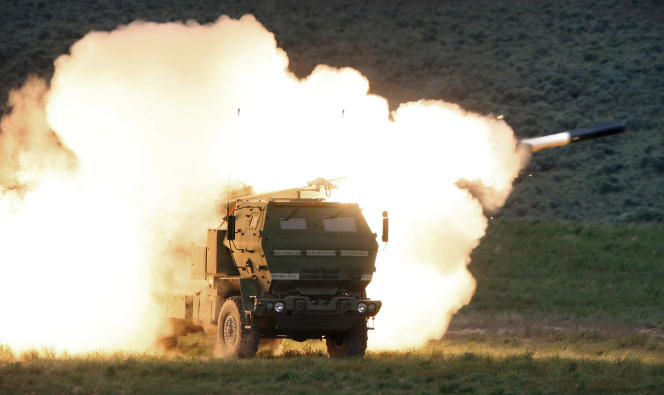Ukraine has called for “long-range” Western artillery weapons that it says would allow it to quickly retake the strategic city of Sievierodonetsk. The delivery of multiple rocket launcher systems, with a range of some 80 kilometers, slightly greater than the Russian systems, has been announced by Washington and London, but it is unclear when the Ukrainians will be able to start using them.
Yohann Michel, researcher on military and defense issues at the International Institute for Strategic Studies, answered your questions during a chat on Friday, April 10.
There is indeed a lag between certain announcements and deliveries. It really depends on the strategy of the states that come to the aid of Ukraine: some prefer to announce first and then deliver, others to deliver first and only announce after delivery. In any case, there are more or less delays depending on the materials: you have to adapt the means of communication, sometimes translate certain elements…
Some States have equipment similar to the equipment already in service in Ukraine, which reduces delivery times. In other cases, more in-depth work is required. Then it is necessary to take into account the training times of the personnel who will have to use it, as well as the transport times.
Finally, the question of whether these deliveries will arrive “on time” cannot be directly answered: it will depend on the situation on the front, which sometimes evolves slowly, sometimes quickly. Surprises can happen on either side.
Even if the quantities promised are indeed often very low compared to the (estimated) stocks of the Russian army, it is always preferable to a situation where the Ukrainian forces would be condemned to a slow erosion of their own arsenal. But some of this equipment brings real added value, especially when it allows the Ukrainians to fire further than the Russian artillery. Or, as with the Caesars delivered by France, when their artillery pieces benefit from better range and greater mobility. This is a real advantage.
It is difficult to give a precise answer. It also depends on how they will be delivered: drop by drop? A delivery of several dozen systems, with trained servants, would have a significant impact. In reality, the most important thing is to form coherent units, using the same material if possible. The rest will depend on Ukrainian strategy and the Russian response. Moreover, it will take Ukrainian forces to exploit all the advantages offered by Himars and other long-range systems.
Long-range artillery will notably allow the Ukrainians to achieve better counter-battery fire. If they manage to reduce part of the Russian artillery in an area, exploitation by the rest of the Ukrainian army will be easier. For now, the Russian artillery enjoys several important advantages in this sector; anything that can allow the Ukrainians to reduce this imbalance will be good for them.
Their ammunition reserves are difficult to estimate. It is likely that the Russian army can continue these bombardments for much longer. The question of men will be more sensitive: the lack of personnel seems important on both sides.
Ukraine has not exhausted its arsenal, but its ammunition stock is dwindling and Westerners can only manufacture a limited amount of ammunition of the calibers used by ex-Soviet equipment (e.g. 152mm). Deliveries of 155 mm artillery pieces, a NATO caliber, allow Westerners to deliver their own stocks of ammunition, which makes it possible to support Ukraine for a much longer period. Same advantage for spare parts and other means of communication.
Both. There are no specifically offensive or defensive weapons. For example, the same artillery piece can defend a territory, and potentially avoid losing it, but also increase the cost of its capture by the enemy. The following week, it can participate in an offensive aimed at retaking it, or an offensive in an entirely different sector.
Broadly speaking, this is where the political question comes back: if Ukraine resists an aggressor in order to defend its territory and its population, then these weapons help it achieve that objective. If Ukraine decided to change its war aims (which is highly unlikely), then the same weapons would have another purpose.
Be wary of articles that condemn a particular weapon system. It will take decades to learn all the lessons from this conflict. We are still discussing the usefulness of such and such a system during the First World War…
Attrition [the depletion of human and material resources] is always very important in this type of conflict between modern states. Let us remember, moreover, the extent of the destruction suffered by the Iraqi army in 1991. There again, there is no weapon that will offer the answer. It is the combination of certain tactical choices, the coordination of forces and means, the quality, the will and the intelligence of the women and men who implement the whole, as well as the opponent’s response that will make difference one way or the other. Technique is only one part of this whole. Tanks, helicopters and other equipment are always used (and claimed) by both adversaries.
Western European countries have generally maintained smaller arms stocks than Central and Eastern European countries. So they usually have less equipment available to deliver, unless they use equipment from the armed forces themselves.
Unfortunately, these are also very reduced. France only has 76 Caesars available for its own forces. This is already insufficient for itself. In addition, France has been engaged in external operations for years, and has not chosen to acquire larger ammunition stocks. She uses more and doesn’t have enough stock “just in case”. So she can’t provide a lot. This is a choice that has been criticized for years by many observers.
Apart from these aspects, there are also the political choices of these same Western European countries and their own relationship to the use of armed force – I am thinking here in particular of Germany.
The phrase “luxury craftsmanship” is, of course, an image, but an image unfortunately quite close to reality. It takes a long time to manufacture certain equipment, and we have chosen to only obtain limited volumes. Our industry is therefore cut out for the orders that we carry out in normal times. One of the possible answers would be to take greater account of the potential need for rapid recovery in our industry, as soon as our equipment is ordered. There is a lot to think about on this point, and it is work to which researchers like me will contribute in the coming months.
Unfortunately, this is a common situation for the majority of NATO countries. The United States is a special case, but even they have limited stocks: these wars between modern states are very resource intensive.
It would take too long for this chat to properly summarize all these aspects, but I take the liberty of recommending an excellent podcast from the Institute for Strategic Research of the Military School (Irsem), in particular this episode, which comes back precisely (and very clearly) on these different aspects.
The anti-ship missiles that have been reported as being delivered have yet to be seen by independent observers. For the moment, we can therefore neither say that they are present on the Ukrainian coasts, nor what their impact could be. But the mere announcement of their presence could have a deterrent effect on the Russian navy, which should take this into account. As they should have taken into account the known presence of the Neptune missiles which (presumably) sank the Moskva. Since the loss of the Moskva, the Russian Navy has made several landfalls from its ships.
In particular, Russian forces are trying to destroy bridges, which are vital for Ukrainian logistics on the Dnieper. The same goes for railway installations. I take this opportunity to point out that this is another aspect that has been relatively ignored by Western armies since the end of the Cold War: we lack specialists for rail logistics and the rehabilitation of railway tracks. The Ukrainians are making a major effort on this side, but the Russian forces have succeeded in several bombardments (which does not prevent reconstructions).
Ukraine reported receiving spare parts for fighter jets, but did not identify a supplier. Several Central and Eastern European countries may have participated in these deliveries, which are difficult to estimate.
Ukraine regularly carries out fire support missions – which consist of isolating, harassing, neutralizing or destroying enemy forces which exercise direct action on friendly forces, or are likely to do so in the short term – and bombardments in the planes and helicopters. Mig-29, SU-27 and other SU-25s are still flying. A Ukrainian SU-27 has also been shot down in recent days. The Ukrainian armed forces also have ground-to-air defenses which continue to reduce the freedom of action of the Russian air forces. However, the latter still have a real advantage.
Most engineers, workers and other employees and managers of arms companies are people like you and me. If they are proud to see that their work can make a difference, they are not particularly happy to witness these horrors.
That being said, several states have already announced that they are increasing their budget for orders for new equipment (Germany being an example). The Netherlands has also signaled that it will increase its stockpile of ammunition. This is undoubtedly a direct consequence of this conflict.
Artillery is indeed one of the particularly important weapons in these battles in the Donbass. Armored vehicles are still used, however. The change in Russian war aims concentrates fighting in certain regions of Ukraine. The density of forces in this sector limits the possibilities of movement: the fronts are more difficult to break through and artillery duels are particularly important here.
But they are not alone, and the infantry are still fighting. It is she who takes and holds the ground. Here as elsewhere, it is the combination of weapons and effects that makes the difference. All weapons are important.
Ukrainian forces unfortunately need a lot of things. First ammunition, but also artillery of various calibers: if possible self-propelled, but if these guns are towed, they will do with it: they need parts. The French Caesars and the Slovak Zusana 2 are wheeled, and therefore particularly mobile. But the equipment delivered by the Norwegians or the Poles is also particularly useful.
Finally, in any case, precision or long-range ammunition offers great advantages (especially) during artillery duels. But they also need tanks and infantry fighting vehicles, to hold the ground and, one day, retake it, as well as command, communications and, of course, anti-aircraft tools.
The use of TB2 drones against tanks, artillery and many other types of targets is attested in the conflict in Ukraine. The Ukrainians even reported that the TB2s had been used against Russian ships and took part in the destruction of the Moskva. TB2s are also at the heart of Ukrainian communication, from Bayraktar singing to various iconographic tools.
Each particular equipment brings an advantage, but cannot constitute a turning point on its own. The use of Switchblade kamikaze drones is nevertheless attested in the field.
Generally speaking, just because you don’t see a lot of cyberattacks doesn’t mean there aren’t any: defenders are playing their part here, and it looks like cyber activity is particularly brisk, from two sides.
Physical strikes have been numerous on many types of targets – including grain silos – and throughout the depth of Ukrainian territory, and this since the beginning of the conflict. Nevertheless, the Russian forces obviously have a limited stock of long-range missiles and cannot afford to carry out the same type of air campaigns that the Americans have accustomed us to since 1991.
Allow me again to recommend another episode of “Collimateur”, the Irsem podcast, as well as this excellent study.
But I can try to summarize. First of all, the Russian forces failed in their attempts to annihilate the Ukrainian Air Force. Some strikes hit inoperable aircraft and missed aircraft still in service, and the Ukrainian air force had visibly dispersed before the strikes. Finally – and above all – Ukrainian pilots and airmen are both courageous and obviously very good. I would also like to point out that before February 24 I did not think that the Ukrainian air force could survive the first week of the conflict: I was wrong, the Ukrainians proved me wrong.
Ukraine says it still has reserves and volunteers who have not yet started their training. It remains to be seen what it really is. It is difficult to estimate these reserves with our limited resources. International volunteers take on their full importance here. Both sides face high attrition, and this rate of loss is likely not sustainable by either side.
It should also be remembered that it is the whole of Ukrainian society that bears the brunt of these losses: it is engineers, designers, bakers who will be missing for decades to come. But Ukrainians seem to consider it a tolerable price given the stakes. War is above all a conflict of wills, and obviously the two camps have not exhausted their reserves on this side.
The Ukrainians seem to benefit from intelligence not only from the United States, but also from other actors. France, the United Kingdom and the Swedes have electronic warfare devices loaded with sensors that regularly fly in the area. Not to mention private actors who may collect information on behalf of other actors, without it being possible to be certain of whom. Ukraine is therefore likely supported by many countries. There is also satellite intelligence, which is more difficult to observe with our resources.
We must beware of judging the (perceived) absence of significant effort in this or that sector, or front: we have difficulty in estimating the forces present, and the means equally available, on both sides, and we do not only have part of the information, without knowing exactly what they know and what we don’t know. Let’s stay humble.
France is a major arms supplier, if we take into account the value of its arms sales – a few Rafales or submarines represent a large volume in euros – but not necessarily a large volume of equipment, in particular on the side of ammunition and missiles.
In addition, there are supply difficulties for certain raw materials and other electronic components, which limits everyone’s production. Finally, the structures of our industries are big machines that are difficult to change on short notice. The rise in power must be anticipated and our industries and policies will (I hope) work on it. A set of questions which will probably be addressed next week at Eurosatory (large Arms Fair which is held from June 13 to 17 in Villepinte).














